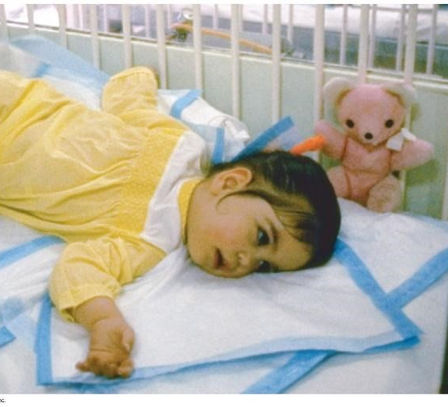TAY-SACHS DISEASE
It is an extremely rare genetic disorder in which the enzyme that breaks down fatty acids in the body is absent.
Frequency
Its variants are frequently found in Eastern and Central European Jewish communities; also common in Quebec French-Canadian communities, Louisiana Cajun population and Pennsylvania Old Order Amish community.
Inheritance
Tay-Sachs disease is inherited in an autosomal recessive pattern.
History of Disease
The first recorded case was observed by the British ophthalmologist Warren Tay in 1881 when he observed the retina of a one-year-old patient which has a cherry-red spot and exhibited physical and mental retardation, clearly a sign of degenerative function of the central nervous system. The disease was named after Warren Tay, for his observation about the cherry-red spot on the retina of the eye, and American neurologist Bernard Sachs for his observation in the cellular changes in patients diagnosed with the disease and increased rate of disease in Ashkenazi Jews.
Brief Summary
Pathogenesis
Tay-Sachs disease is caused by mutations in the HEXA gene that is located on chromosome 15 at position 24.1. Hexa gene provides instructions for producing beta-hexosaminidase A, an enzyme that plays a critical role in the brain and spinal cord. It helps break down a GM2 ganglioside, a fatty substance or lipid that is essential for normal metabolism and accumulation of this is highly toxic and may cause cell death. The functionality of the beta-hexosaminidase A is known to be disrupted by the mutations in the HEXA gene, which prevents the enzyme from breaking down GM2 ganglioside. Accumulation of this enzyme causes high significant levels of toxicity in neurons in the brain and spinal cord. As a result, the build up of the GM2 ganglioside causes destruction of the neurons that causes the signs and symptoms seen in Tay-Sachs disease.

Symptoms
1
Infantile Tay-Sachs Disease
-
Progressive muscle weakness
-
Myoclonic jerks
-
Jaundice
-
Exaggerated startle response
-
Loss of motor skills
-
Decreased eye function
-
Shows listlessness and irritability
-
Slow growth
-
Diminished muscle tone
-
Involuntary muscle spasms
-
Development of cherry red spots in the eyes.
-
Seizures
-
Progressive hearing loss
-
Dementia
2
Juvenile (Subacute) Tay-Sachs Disease
-
Loss control of body movements (ataxia)
-
Mental retardation
-
Jaundice
-
Progressive loss of speech
-
May or may not develop a cherry-red spot in the eyes.
-
Degeneration of the nerve that carries impulses from the eye to the brain to form images
-
May have retinitis pigmentosa
3
Late-Onset Tay-Sachs Disease
-
Mood alterations
-
Jaundice
-
Progressive muscle weakness
-
Fasciculations
-
Seizures
-
slurred speech (dysarthria)
-
Inability to coordinate voluntary movements (ataxia)
-
Dystonia
-
Involuntary muscle spasms
-
Mental deterioration
-
Experience of psychiatric episodes such as loss of contact with reality, paranoia, hallucinations, bipolar episodes, and depression
Tay-Sachs disease is a progressive neurodegenerative disorder which, in the classic infantile form, is usually fatal by age 2 or 3 years.
Social Concerns
Genetic testing helps determine a person’s chance of developing or passing on a genetic disorder. Concerns surrounding the disease are as follows:
Psychological
-
Unnecessary anxiety created
Social
-
Expense swell health costs
-
Societal pressure not to bear affected offspring
Treatment
No specific treatment for Tay Sachs disease is available. Treatment is only directed toward the specific symptoms that are apparent in each individual such as:
-
anticonvulsants that may be used to treat seizures
-
nutritional support and supplementation for infants who have feeding difficulties
-
physical therapy to help keep joints flexible and maintain mobility
-
respiratory care such as chest physiotherapy (CPT) for patients who have difficulty of breathing
Clinical Trials
Title:
Effects of Miglustat Therapy on Infantile Type of Sandhoff and Taysachs Diseases (EMTISTD) (EMTISTD)
Intervention:
Drug: Miglustat
Phase:
Phase 3
Procedure:
Treatment with Zavesca regimen based on body surface area as follows: SQRT [Height (cm) × Weight (kg)] / 3600 <1.25 : 200mg TDS 0.88- 1.25: 200mg BID 0.73- 0.88: 100 mg TDS 0.47- 0.73: 100 mg BID <0.47: 100 mg Daily
Other Name:
Zavesca
Goal:
Recent studies have suggested new methods of treatment, such as enzyme replacement therapy, bone marrow transplantation and substrate reduction therapy (SRT). The first drug used in SRT was Miglustat. It was introduced in 1980 as an anti HIV agent and later, it was registered under the trademark of Zavesca in 2009 and was used in treatment of Gaucher and Niemann-Pick disease. Zavesca passes the blood brain barrier, so causes reduction of cholesterol and glycosphingolipids CNS neurons and relief of neurologic manifestations. Improvements were seen in oculomotor function, cognition, swallowing, motor disturbances and psychological problems after treatment with Zavesca. No effect has been proved on visceral involvement. Weight loss during the first year of treatment, diarrhea and dyspepsia are seen as side effects. So this study is done to evaluate the effect of Miglustat therapy in Sandhoff and Tay sachs disease, and is believed to help for further studies in this field.
Further details at:
Expert Directory
References
FOR INFORMATION
FOR IMAGES










